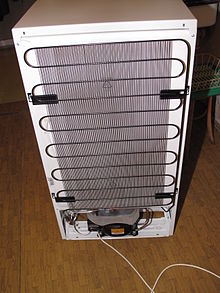Condenser (heat transfer)
A condenser is a heat exchanger used to condense a gaseous substance into a liquid state through cooling. In so doing, the latent heat is released by the substance and absorbed into the environment around it. Condensers are used for efficient heat rejection in many industrial systems. Condensers can be made in multiple designs and they come in many sizes ranging from small (hand-held) to very large (industrial-scale units used in plant processes). For example, a refrigerator uses a condenser to get rid of heat extracted from the interior of the unit to the outside air. This cools the food inside of it.

Condensers are used in air conditioning, industrial chemical processes such as distillation, steam power plants, and other heat-exchange systems. Use of cooling water or surrounding air as the coolant is common in many condensers.[1]
Air conditioning
changeA condenser coil used in air conditioning systems normally has a heat exchanger section to cool down and condense the refrigerant vapor into liquid, a compressor to raise the pressure of the refrigerant and move it along, and a fan for blowing outside air through the heat exchanger section to cool the refrigerant inside.[2][3][4] A normal setup of a condenser unit is as follows: The heat exchanger coil section wraps around the sides of the unit with the compressor inside. In this heat exchanger section, the refrigerant goes through multiple tube passes, which are surrounded by fins through which cooling air can circulate from outside to inside the unit. There is a motorized fan inside the condenser unit near the top, which is covered by a cover to keep any objects from accidentally falling on the fan. The fan is used to pull outside cooling air in through the heat exchanger section at the sides and blow it out the top through the grate. These condenser units are located on the outside of the building they are trying to cool, with tubing between the unit and building, one for vapor refrigerant entering and another for liquid refrigerant leaving the unit to the Evaporator.[5]
References
change- ↑ Hindelang, Man jjhat; Palazzolo, Joseph; Robertson, Matthew, "Condensers", Encyclopedia of Chemical Engineering Equipment, University of Michigan, archived from the original on 24 December 2012
- ↑ "Interior Designers Review: Energy-Efficient Samsung Windfree™ Air Conditioners". news.samsung.com. Retrieved 2024-10-25.
- ↑ "Best 5-star split AC in India: Top 9 air conditioners for maximum energy-efficient cooling". Hindustan Times. Retrieved 2024-10-25.
- ↑ "Maintenance of Air Conditioner" (in Arabic). 2024-10-22. Retrieved 2024-10-25.
- ↑ "Sitting in AC for too long? 5 risks of extended air conditioner exposure". The Times of India. 2024-10-10. ISSN 0971-8257. Retrieved 2024-10-25.